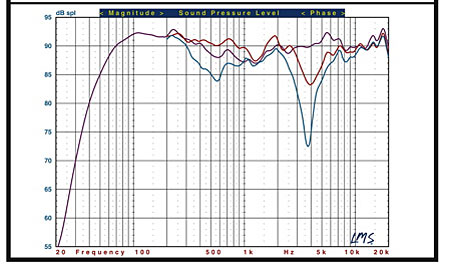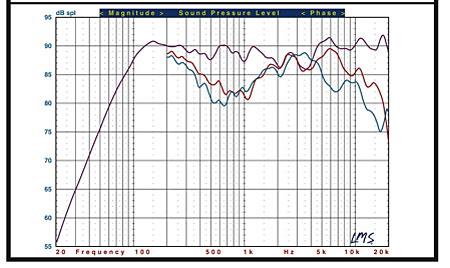Canton GLE Speaker System Measurements
Text by Thomas J. Norton
The measurements shown were taken with the grilles removed. The changes in response with the grilles in place (not shown) were less significant than is usually the case, with only minor deviations at the highest frequencies.
The impedances here were derived from the measured impedance curves (not shown).
All figures: Violet curve: pseudo-anechoic response on the tweeter axis, averaged across a 30° horizontal window, combined with nearfield responses of the woofers (and, in the GLE 470, the port). All measurements were taken at one meter.
GLE 470
Minimum impedance: 4.1Ω at 210Hz
Nominal impedance: 5Ω
Cabinet tuning: 43Hz
Effective bass extension (-10dB): 43Hz (relative to the level at 150Hz)
Sensitivity: 90dB/2.83V/m
The GLE 470 should be a relatively easy speaker to drive provided that the amplifier is comfortable with a 4Ω load.

Fig.1: GLE 470, pseudo-anechoic response, off-center in the horizontal plane, at 45° (red) and 60° (blue).
The measured response of the GLE 470 is relatively smooth, though slightly swaybacked (a gentle dip in the middle). Some listeners, including Gary, like such a response (within reason) as it can make overly aggressive program material more listenable. (Stereophile's John Atkinson, who has probably measured more speakers under review than anyone in the business, once commented that the speakers that tend to get the best reviews measure relatively flat or a little swaybacked.) It also could explain why Gary found the upper midrange and treble so detailed, since these regions are comparatively a bit hotter than the lower-midrange.
Off axis, the response dips to a lower plateau from the upper midrange to the highest treble, but otherwise remains unusually smooth and extended up to the highest frequencies.
The bass is reasonably extended, but not unusually so for a fairly large floorstander. It drops off rapidly below 70Hz.

Fig.2: GLE 470, pseudo-anechoic response at 15° above (red) and 15° below (blue) the tweeter axis.
The vertical listening window of the GLE 470 is relatively critical, with the smoothest response at or near tweeter height. Avoid sitting below the tweeter if possible. But given the height of the tweeter (estimated at under 30 inches), it may be difficult to avoid sitting above it, since typical seated listening heights range from 36 to slightly over 40 inches, depending on the individual and the chair. You could try tilting the cabinet back slightly, or even raising it up on a short standodd as that recommendation sounds.
GLE 470
Minimum impedance: 5.5Ω at 213Hz
Nominal impedance: 7Ω
Cabinet tuning: 94Hz
Effective bass extension (-10dB): 66Hz (relative to the level at 150Hz)
Sensitivity: 88dB/2.83V/m
The impedance results indicate that the GLE 455 is a relatively easy load to drive. There is actually a lower minimum impedance than the one shown above (4.9Ω) but it's at 6kHz, so it shouldn't be significant given the limited power required by most program material at that frequency.

Fig.3a: GLE 455, pseudo-anechoic response, off-center to the left in the horizontal plane, at 45° (red) and 60° (blue).

Fig.3b: GLE 455, pseudo-anechoic response, off-center to the right in the horizontal plane, at 45° (red) and 60° (blue).
The GLE-455's averaged frontal response is good. It's elevated just a bit in the top two octaves but not enough to make the speaker obviously edgy or bright.
Like the GLE 470, the GLE 455 is a 2.5-way speaker, with only one of its two woofers operating up into the midrange. We have seen other such attempts to compensate for the characteristic off-axis dips that occur to the left and right of center in a center-channel speaker in which the drivers are arrayed horizontally. They have never really eliminated this problem, and the approach doesn't appear to help much here, either. The off-axis response irregularities are still clearly visible in Figures 3a and 3b. The only effect produced by the 2.5-way design in the GLE 455's off-axis response is to make it different on each side.

Fig.4: 5C, pseudo-anechoic response at 15° above (red) and 15° below (blue) the tweeter axis.
The GLE 455's vertical response indicates that any reasonable seating position relative to tweeter height should be satisfactory.





























































